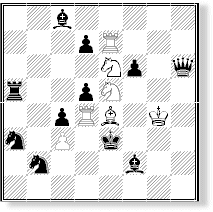 |
Mario PARRINELLO Il tema Zilahi ciclico nell'aiutomatto in due mosse Thee cyclic Zilahi theme |

Recensione
 |
Mario PARRINELLO Il tema Zilahi ciclico nell'aiutomatto in due mosse Thee cyclic Zilahi theme |

Recensione
Tema Zilahi by Mario Parrinello (48 A4 pages, 140 diagrams, plastic ring binding, published by Antonio Garofalo, 2000; Lit. 30000 [EU 15,5]). Please contact Mario Parrinello, Via Avis 25, 46010 Marcaria MN -Italy;
E-mail: mario_parrinello@hotmail.com The Zilahi is that helpmate motif in which the mating piece of each phase is captured in another. It is named after the Hungarian Zoltan Zilahi, although it was probably originated by C.M.Fox. The present booklet has a slightly confusing title, since it deals only with helpmates in 2 featuring the cyclic form of the Zilahi (three phases or more) and it amply proves by the diversity of its content that the Zilahi is not a theme in itself but a unifying framework which may be applied to a whole range of thematic ideas. What is usually thought to be the earliest cyclic Zilahi is quoted here as A. Many later examples are a good deal more complex than this (and of course they very rarely use set play) but it is a remarkable forerunner.
Although the title is imprecise, the booklet itself is admirably clear. The examples are organised into sections according to the motivations of the moves, and although the book as a whole is written only in Italian, the descriptive headings are given also in English. This, along with an index of names, makes it easy to find one's way around even though there is no table of contents. Each problem receives a detailed descriptive comment, typically of about 80-100 words, and the layout, with small but very clear diagrams interspersed in the text and accompanied with solutions in figurine notation, makes for very comfortable reading.
The booklet is clearly intended mainly for reading, rather than solving or reference, and will consequently appeal to all helpmate enthusiasts. Even those who mistakenly consider the Zilahi rather abstract will be entertained by the variety of strategy on view. The quality of the problems ranges widely, from the excellent to the truly appalling, a feature I find appealing since the bad always helps one to appreciate the good. Although for my own taste 1 rather regret that the author's renowned technical expertise has not often been used for comments on the construction of the problems, I acknowledge that this aspect will not be important to most readers. The main thing is that all the examples are interesting in one way or another. And although the author wisely makes no claim to have produced a complete review of the cyclic Zilahi, I would guess that a fair proportion, certainly more than half, of all currently existing examples is included here.
The publisher, in a brief introduction, expects that many errors will be found. From personal experience I know that it is impossible to eliminate them entirely, but in this case they are commendably few, not much more than some slightly incorrect or missing dates and a couple of mistakes in the names of Macleod and Schneider. (These errors in the review copy have now been corrected. A.G.) The latter, whose brilliant early third-batteiy problem is quoted as B, is indeed not Stefan but Vilmos Schneider, one ofthe finest ofall helpmate composers, still alive but alas no longer active. Another feature 1 have noticed highlights an unexpected difficulty for writers of such books: Five examples are given in their original settings although they also exist in later (sometimes much improved) versions by the same composers. It is veiy difficult for writers to keep track of such things, so we should blame not the author but the composers, who should have done a better job in the first place!
1 hope that this booklet finds a wide readership, encouraging the author to produce further work in the same style.
Schachmatt 1947
H#2**
1. ... Cb3 2.R:c4 A:e2#
1. ... A:e4 2.R:d2 Tc2#
1. g:f3 C:f3 2. Ad2 Ce5#
3° Pr. Magyar Sakkelet 1965
H#2 3.1.1.1
1. d:e6 A:d5 2. e:d5+ Cd7#
1. f:e5 Cf4 2. e:f4 Ag6#
1. d:e4 Cf3 2. e:f3 Cc5#C. J. Feather, November 2000

Introduzione
Questo libro e il primo scritto da Mario Parrinello, ed è uno dei pochi dedicato ai problemi scritto in Italia, specie negli ultimi tempi. Mario mi ha chiesto di scriveme 1'introduzione; anche per me è la prima volta, spero scuserete la mia inesperienza.
L'autore ha avuto l'idea di riunire 140 aiutomatti in due mosse, tutti sul tema Zilahi, un te ma molto in voga negli ultimi decenni. Potrà forse sembrare noioso vedere, uno dietro 1'altro, tutti questi problemi con lo stesso tema, ma vi assicuro che ne vale la pena, sono dei veri capolavori e l'autore, come certo sapete, è un esperto degli aiutomatti; chi meglio di lui poteva descrivere con dovizia questi lavori di altissimo livello?
L'autore ha diviso i problemi in gmppi e sottogruppi, ognuno con certe peculiarità. Per chi non conoscesse il tema, nelle prime pagine c'è la doverosa spiegazione. I titoli dei gruppi e sotto- gruppi sono scritti anche in inglese, per favorire i nostri colleghi all'estero; per il resto, ciò che importa sono, alla fine, i problemi e le loro soluzioni, scritte in linguaggio intemazionale, ovvero con figurine.
Mario Parrinello, nato nel 1960, è medico cardiologo; ha iniziato l'attività problemistica nel 1977, pubblicando circa 300 problemi e ottenendo più di 30 premi, 60 menzioni e 50 lodi; Maestro FIDE della composizione, è uno dei migliori compositori italiani; dobbiamo essere fieri di questo libro e sperare che ci siano altre iniziative del genere.
Due parole sull'editore, me medesimo: è la prima volta che provo a stampare un intero libro (anche se possiamo definirlo libretto o, in inglese, booklet); errori ne avrò fatti tanti, ma per favore, "non sparate sul pianista"...
Buona lettura!
Antonio GAROFALO
 Ritorna a
Ritorna a 